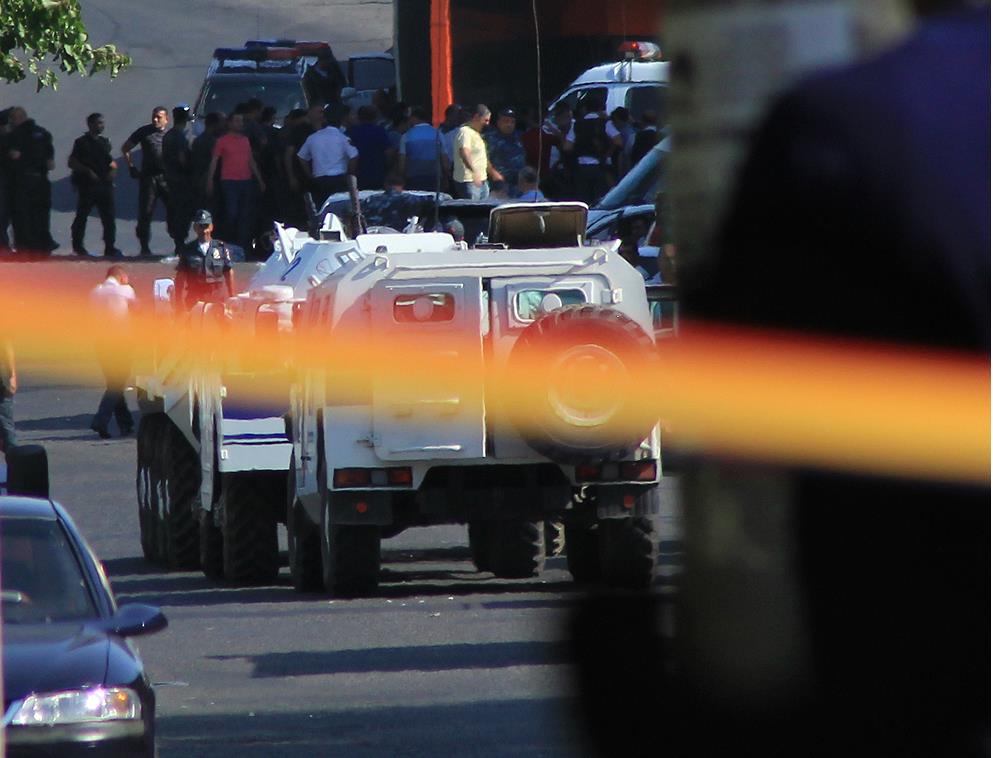What do the rebels want?
Early on July 17, a group of individuals referring to themselves as the “Sasna dzrer organization, announced that they would be seizing a patrol police regiment in Yerevan. One of the members of the group, Varuzhan Avetisyan, was actively disseminating reports about the seizure via Facebook, discussing the beginning of an armed uprising and calling for the mobilization of the people. “The revolution has begun, join us, he wrote, calling on people to take to the streets and start overthrowing the government.
But the people woke up later than the state agencies, and while they were trying to go out into the street and find out what the matter was, the state agencies blocked communications between the group and took the situation into their own hands.
It was later reported that the group demanded the release of Jirayr Sefilyan, who had been arrested a month ago for the illegal possession and transportation of firearms. Sefilyan coordinated the radical oppositionist initiative “New Armenia, involving many members of the rebel group. In addition, the group also demanded the resignation of Serzh Sargsyan, at the same time insisting on bringing Sefilyan into, who would then announce how things would proceed.
One day after the police had been seized, the group’s demands have still not been met, though contact with Jirayr Sefilyan has been established. Representatives of the Armenian opposition met with him and then communicated his words to the rebels, who were besieging the patrol police station. As a result, two hostages, a police officer and an ambulance driver, were released tonight.
According to Varuzhan Avetisyan, contact with Jirayr Sefilyan was established and a ‘third option’ was being discussed, which, however, rules out Sefilyan’s release. It is hard to say what he is suggesting, but, judging by the fact that both the police and the group are trying to avoid aggressive actions, both sides are inclined towards coming to a peaceful resolution without any bloodshed.
However, blood has already been shed. Artur Vanoyan, a police colonel, was killed and several people were injured, two of which are in critical condition. And the very fact that it was blood was indeed shed, is assessed by many experts as a prerequisite for the mandatory arrest of the rebels, even in case of voluntary surrender.
No one in Yerevan can tell for sure what those 25-30 people had been counting on when they decided to take such a desperate step. Some oppositional political forces in Armenia made statements in which they rested all of the responsibility for the situation on the incumbent government.
Political parties, including the “Heritage”, “Civil Agreement”, and others, claim that the lack of legal means present in order to change the power at be and influence government decisions lead to the radicalization of the political struggle.
Other parties, including pro-governmental Dashnaktsutyun and “Prosperous Armenia”, condemned the violent methods used to impose the group’s decisions.
Experts say the rebels were probably counting on people’s support, expecting a mass uprising throughout the country. However, the group’s potential supporters were brought to police stations on Sunday, where they were held in custody for 10 hours and then released. The wider public did not take to the streets.
 photo: Gevorg Ghazaryan, Yerevan
photo: Gevorg Ghazaryan, Yerevan
The analysts attribute this to the group’s lack of political and understandable demands. On the one hand, this harkens to the need for Serzh Sargsyan’s resignation, but, on the other hand, suggests some alternatives, claiming it has no intention to come to power. It is difficult to expect any public support with such controversial demands.
Although there is indeed great public discontent with the authorities, the rebels’ proposed mechanics of popular uprising didn’t win the people’s trust and wasn’t supported by them either. Perhaps this was the reason for the current impasse, from which everyone now is looking for a decent and relatively painless way out.
Few people dare predict how will this story end. There is also no analysis of the situation in terms of the external conjuncture: whether it is a purely internal uprising or part of a larger regional scheme. Some experts draw parallels with the recently attempted military uprisings in Turkey.
Many experts believe that the failed coup attempt in Turkey will lead to the strengthening of Erdogan’s power- thousands of people have been already arrested and disloyal judges, governors and military personnel have been dismissed.
However, despite the obvious parallels, the recent incident in Armenia is unlikely to lead to people ‘tightening up the screws’. The peculiarity of President Serzh Sargsyan’s ruling is in the almost unlimited freedom of speech, assembly and expression, and, at the same time, almost lack of influence of the public opinion on the government’s decision-making it contains.
The only result that the uprising in Yerevan may bring is a common understanding that even while being totally under someone’s control, there will always be people in the public who are ready to resort to drastic measures. This is true in Armenia, where the government’s intention to make territorial concessions on the Karabakh issue has been so actively discussed these days.
The uprising in Yerevan, the initiators of which stated their feelings that territorial concessions would not be tolerated, proves that such decisions could face radical resistance on the part of the public.


















